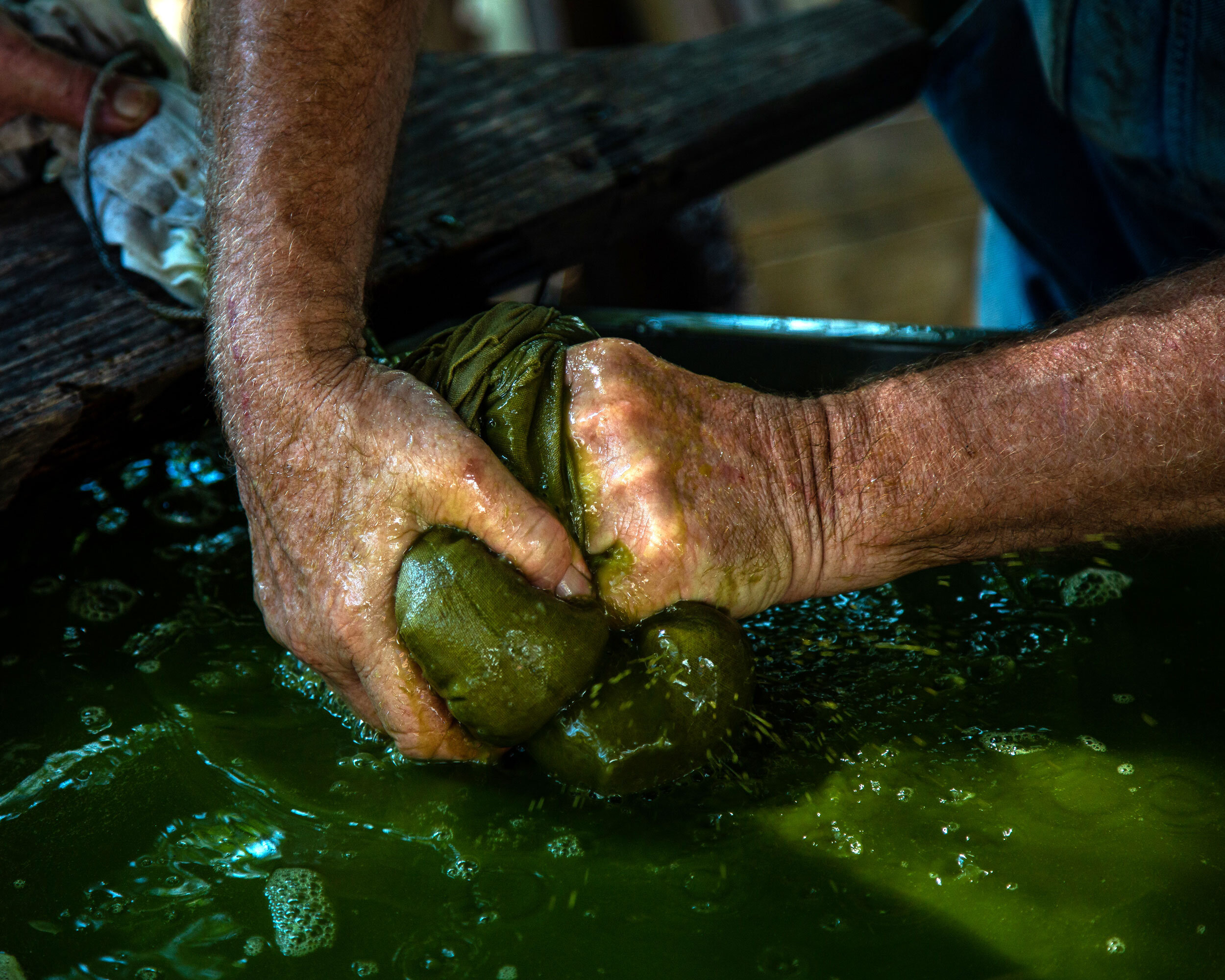Sorghum is one of those crops you either know or you don’t. Some varieties are grown for the seeds, but Appalachian folk grow a kind of sorghum for the thick juicy cane. Technically, molasses comes from sugar cane, but in the mountains, “molasses” is almost always shorthand for sorghum syrup. Here’s a little primer for boiling down frothy green sorghum squeezings into a finger-licking pot of sticky-sweet goodness.
Story & Photographs by Chelsey Mae Johnson
How to Make Molasses
First, realize you are not making molasses.
Not unless you’re in the tropics — maybe Louisiana, Georgia, or Florida — and you’re at a near-commercial level of production with sugar cane, genus saccharum. You cannot miss true sugar cane; it grows up to 20 feet tall and each stalk is obscured by a dense tangle of leaves that will slice bare skin right open.
If you’re anywhere else in the United States, and especially if you’re in the Appalachian Mountains, you’re dealing with sweet sorghum cane. Sorghum bicolor. Somebody driving by a sorghum patch might miss it, because from a little ways back it looks a lot like corn. You’re going to work a few hundred hours in that patch to raise cane and make it into a syrup you might eventually pour on a biscuit, and you’re going to call it molasses, too.
You will haul the 5-gallon buckets rustling with last year's seed heads out of the shed in the early summer, and you will get the seeds into the ground at just the right time. You will know when it is the right time because you have done this for 50 years; 50 batches of buckets; 50 early summer days. You may hitch up a mule and till the patch before planting, or you may use a tractor. It depends on how you’re feeling this year — depends on your knees, your back, your knuckles.
Watch as the cane stalks grow taller than your hounds, then your horses. Watch your bees help this patch through June, July, August. Rob the honey. Whelp the puppies. Bring in the scuppernongs for jelly; and when the apples start to come, watch the seed heads. As long as they sway green atop the cane, your attention is welcome elsewhere. When they start to flush garnet, put out the call to your friends and neighbors. Once they’ve dried to a burnished oxblood, you’ve got a few long weekends ahead of you.
Sorghum is originally from Africa, but has a long tradition as a crop in Appalachia and cooler regions of the South. The seeds can be popped like popcorn or milled into flour, the stalks pressed for their juice, and the spent cane makes excellent fodder for horses and cattle.
The first days will be spent with however many of those friends you can wrangle, stripping cane in the patch on the crest of the hill. They will come decked in ball caps and straw hats and strong gardening gloves, those available to help in the daylight hours but not yet too old to work in the midday sun. Together you’ll peel the floppy leaves away, leaving a field full of swaying green stalks about as big around as a broom handle. On a second pass, you’ll chop the tops and the bottoms, tossing the seed pods aside to fill next year’s buckets, piling the now-smooth sticks into the bed of the truck. To prep a quarter acre, allow about a week.
Haul out the ancient mill, scrub the boiling pan, get the tractor and loaded truck beds into position. You need to be grinding by 7 a.m. if you aim to sleep at all the night of the first run.
In the morning, have coffee, have some pancakes too. Gather the eggs, feed the dogs. Shuck your jacket knowing the late September day will soon swelter. Wait for whoever will show up first to help; you need at least one other to run the mill efficiently. Tamp down your impatience as your watch hand slides past 7. Greet your buddy’s truck with a wave, fire up the tractor before the dust of the driveway has settled.
Stand in the sun. Stand there as it climbs over the poplar tops right into your eyes, making you squint while you feed 70 cubic feet of stalks through, a couple at a time. Chat easy over the comfortable rumble of the tractor and let those with younger backs pitchfork the papery piles of spent cane stalks into a trailer. Be realistic about the convenience of the tractor, geared just so to run these antique steel rollers, but wish it were horses snorting slow circles around you to turn the mill — that you still had the time and the help and the knuckles and knees to use horses.
Check that the trickle of juice is steady, joggle the hose that runs down the hill to the pan. Squeeze the bloated filter bag when the sediment buildup overpowers the gravity flow and juice starts to create tiny fountains through pinprick holes in the linen. Watch the murky green waterline climb the stainless sides, smelling like cut grass and corn sweetness, and do not think of it as looking like pond scum, or kale juice, or anything except exactly what it is.
Break for lunch. Share what everyone has brought: casseroles and dips and layered desserts, a basket of apples and a cut crystal bowl of foxy grapes, cold cornbread and chow-chow and Yoo-hoos, all spread on card tables under a tent set out for the occasion.
Start the fire while everyone else is still eating. Push and pile wood all the way to the back of the 6-foot pit under the boiling pan. Stoke the blaze while they grind the last stalks, waste no time waiting when it isn’t necessary.
Cut the tractor engine, spray away all the stickiness, tidy up the grinding gear enough to last till tomorrow morning. Pull up a chair next to somebody you’ve been meaning to catch up with. Wait.
Skim the junk as the juice begins to bubble, scooping froth with a small shovel that looks like it’s been blasted with buckshot. You ought to skim, but you really don’t have to skim all the time, not like they say. You just have to watch it, keep it pretty clean. Keep the fire hot. Keep the conversation flowing. Expect to keep on skimming, stoking, and telling old jokes for 8 or 10 hours.
You will not smoke, or chew, or drink anything but the coffee your daughter brings from the upscale market she manages. She grinds it for you right there in the store, and you perk it on the stove, and your son passes around Styrofoam cups in the darkening hours and everybody has some. The last of the jar flies whine loud. The air cools, finally.
Dip the scoop into the simmer, then swing it back and forth in a slow arc to cool the layer of syrup that’s stuck. Let it form little drips, see how thick they are. See if it tastes right. When it’s ready — when the green has gone gold then caramel then the color of rich peat, shining and beading up strings of bubbles like frog eggs — assemble four to lift the steaming pan like pallbearers, shuffling over to the bare soft dirt by the driveway and setting it there to cool. Let some younger person ladle the syrup into a clean sack to be filtered so you can spend the time tracing your finger through film left coating the pan, licking up this last earthy sweetness of the season.
If you had good weather this year and the juice got to the right sugariness and your luck in general is running high, today’s 120 gallons of thick green juice will yield 10 gallons of molasses.
When someone asks you what advice you might give to someone younger who wants to be like you, to try their hand at raising sorghum cane, say, "It’s work." Say, "If you charged $50 a quart, you wouldn’t make 5 cents an hour for the work you put in." Maybe just laugh, and say, “Good luck.”
How to Learn How to Make Molasses
Chat up an older man selling honey in his overalls at a fiddlers convention in western North Carolina. Pay attention when he says he’s been raising cane and coon hounds on a piece of family land a few miles down the valley, just about as long as he can remember. Give him a call around molasses-making time, be curious and sweet, get an invite to his family boil.
Spend your birthday weekend watching syrup boil, even though your boyfriend’s come to visit for only the second time this year, even though you had plans, even though you’re hungover. It’s ready when it’s ready.
Get lost the first, third, and fourth visits. Gag helplessly at the smell of the chicken farm a few miles up the road. Worry that your car won’t make it back up the steep driveway. Worry that your accent isn’t strong enough. Wear the right boots, but bring the wrong thing to the potluck.
Stand in the sun. Sweat through your black V-neck, know that the mirrored sunglasses are ostentatious but know that without them you’ll get a headache.
Recall that even though you grew up here, in these mountains, you did not taste sorghum until you worked in a very expensive restaurant for a chef obsessed with the food of Appalachia. No one in your family romanticizes this bitter, salty sweetener. After a lifetime of working graveyard shifts at the plant, your grandparents retired loving Charms Blow Pops and Reese’s Puffs, loving to watch you stuff your tiny-toothed mouth full of their store-bought sweets.
In a good year, a 120 gallon pan of fresh juice will yield 8-10 gallons of finished sorghum molasses.
Break for lunch. Assume this means you should make an exit; realize that is impossible and rude, besides. That even toting your own water bottle instead of accepting a cold drink comes across as borderline impolite.
Want to be involved, do work, get your hands sticky. Worry too much about being in the way. Hang back.
Coo and pet the puppies. Call them cute then wonder if this is offensive, these being serious and expensive working dogs. Feel better when you’re told nobody’s ever seen a redbone puppy that wasn’t cute.
Wait around. Sit and talk. Listen to stories not told for you, watch it get dark. Watch everything.
Think, damn, this is a long day. This is work.
In memory of Stanley “Cotton” Marley (1950-2020), who loved to share his knowledge of mountain traditions. All photos were taken September 2019 in Wilkes County, North Carolina.
This project is a component of the In These Mountains: Central Appalachian Folk Arts and Culture initiative and supported in part by South Arts, a nonprofit regional arts organization.
Chelsey Mae Johnson is an MA candidate in Appalachian Studies at Appalachian State University in Boone, North Carolina. She researches and writes about food traditions, folk artists, and kitsch culture.















